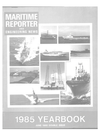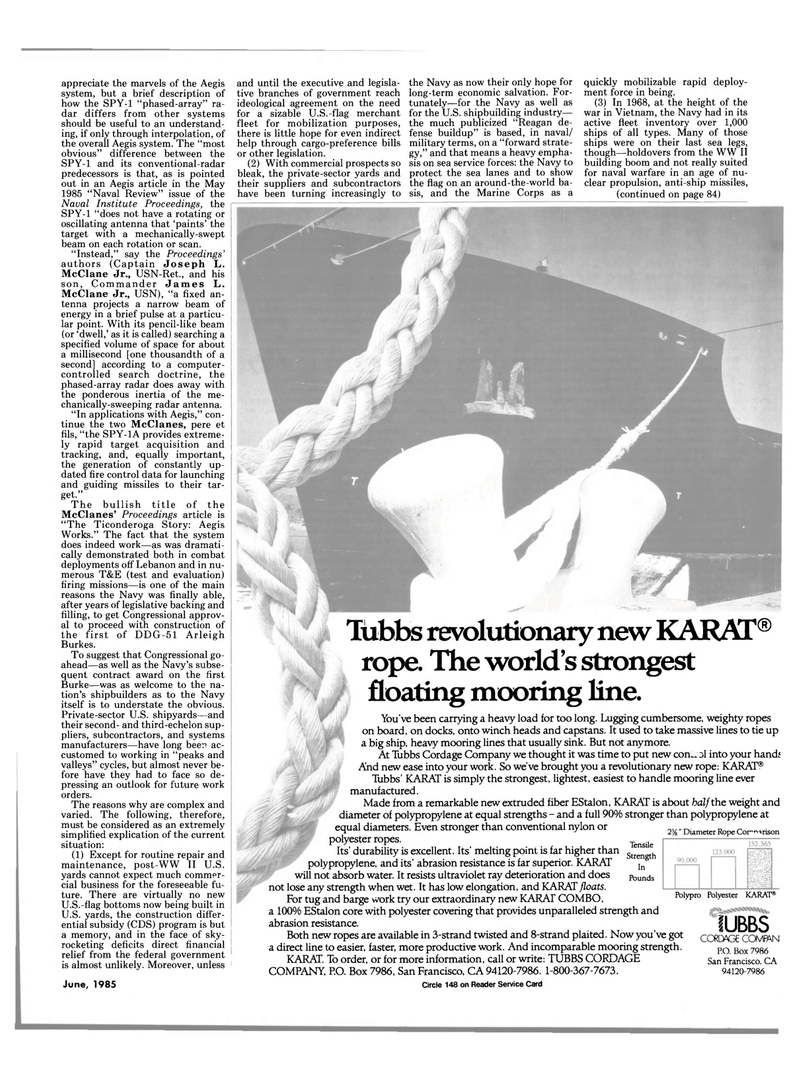
Page 85: of Maritime Reporter Magazine (June 1985)
Read this page in Pdf, Flash or Html5 edition of June 1985 Maritime Reporter Magazine
appreciate the marvels of the Aegis system, but a brief description of how the SPY-1 "phased-array" ra- dar differs from other systems should be useful to an understand- ing, if only through interpolation, of the overall Aegis system. The "most obvious" difference between the
SPY-1 and its conventional-radar predecessors is that, as is pointed out in an Aegis article in the May 1985 "Naval Review" issue of the
Naval Institute Proceedings, the
SPY-1 "does not have a rotating or oscillating antenna that 'paints' the target with a mechanically-swept beam on each rotation or scan. "Instead," say the Proceedings' authors (Captain Joseph L.
McClane Jr., USN-Ret., and his son, Commander James L.
McClane Jr., USN), "a fixed an- tenna projects a narrow beam of energy in a brief pulse at a particu- lar point. With its pencil-like beam (or 'dwell,' as it is called) searching a specified volume of space for about a millisecond [one thousandth of a second] according to a computer- controlled search doctrine, the phased-array radar does away with the ponderous inertia of the me- chanically-sweeping radar antenna. "In applications with Aegis," con- tinue the two McClanes, pere et fils, "the SPY-1A provides extreme- ly rapid target acquisition and tracking, and, equally important, the generation of constantly up- dated fire control data for launching and guiding missiles to their tar- get."
The bullish title of the
McClanes' Proceedings article is "The Ticonderoga Story: Aegis
Works." The fact that the system does indeed work—as was dramati- cally demonstrated both in combat deployments off Lebanon and in nu- merous T&E (test and evaluation) firing missions—is one of the main reasons the Navy was finally able, after years of legislative backing and filling, to get Congressional approv- al to proceed with construction of the first of DDG-51 Arleigh
Burkes.
To suggest that Congressional go- ahead—as well as the Navy's subse- quent contract award on the first
Burke—was as welcome to the na- tion's shipbuilders as to the Navy itself is to understate the obvious.
Private-sector U.S. shipyards—and their second- and third-echelon sup- pliers, subcontractors, and systems manufacturers—have long beer ac- customed to working in "peaks and valleys" cycles, but almost never be- fore have they had to face so de- pressing an outlook for future work orders.
The reasons why are complex and varied. The following, therefore, must be considered as an extremely simplified explication of the current situation: (1) Except for routine repair and maintenance, post-WW II U.S. yards cannot expect much commer- cial business for the foreseeable fu- ture. There are virtually no new
U.S.-flag bottoms now being built in
U.S. yards, the construction differ- ential subsidy (CDS) program is but a memory, and in the face of sky- rocketing deficits direct financial relief from the federal government is almost unlikely. Moreover, unless and until the executive and legisla- tive branches of government reach ideological agreement on the need for a sizable U.S.-flag merchant fleet for mobilization purposes, there is little hope for even indirect help through cargo-preference bills or other legislation. (2) With commercial prospects so bleak, the private-sector yards and their suppliers and subcontractors have been turning increasingly to the Navy as now their only hope for long-term economic salvation. For- tunately—for the Navy as well as for the U.S. shipbuilding industry— the much publicized "Reagan de- fense buildup" is based, in naval/ military terms, on a "forward strate- gy," and that means a heavy empha- sis on sea service forces: the Navy to protect the sea lanes and to show the flag on an around-the-world ba- sis, and the Marine Corps as a quickly mobilizable rapid deploy- ment force in being. (3) In 1968, at the height of the war in Vietnam, the Navy had in its active fleet inventory over 1,000 ships of all types. Many of those ships were on their last sea legs, though—holdovers from the WW II building boom and not really suited for naval warfare in an age of nu- clear propulsion, anti-ship missiles, (continued on page 84)
June, 1985 Circle 148 on Reader Service Card
Tubbs revolutionary new KARAT® rope. The world's strongest floating mooring line. 2% " Diameter Rope Coi~orison
You've been carrying a heavy load for too long. Lugging cumbersome, weighty ropes on board, on docks, onto winch heads and capstans. It used to take massive lines to tie up a big ship, heavy mooring lines that usually sink. But not anymore.
At Tubbs Cordage Company we thought it was time to put new con., ol into your hands
And new ease into your work. So we've brought you a revolutionary new rope: KARAT®
Tubbs' KARAT is simply the strongest, lightest, easiest to handle mooring line ever manufactured.
Made from a remarkable new extruded fiber EStalon, KARAT is about half the weight and diameter of polypropylene at equal strengths - and a full 90% stronger than polypropylene at equal diameters. Even stronger than conventional nylon or polyester ropes.
Its' durability is excellent. Its' melting point is far higher than polypropylene, and its' abrasion resistance is far superior. KARAT will not absorb water. It resists ultraviolet ray deterioration and does not lose any strength when wet. It has low elongation, and KARAT floats.
For tug and barge work try our extraordinary new KARAT COMBO, a 100% EStalon core with polyester covering that provides unparalleled strength and abrasion resistance.
Both new ropes are available in 3-strand twisted and 8-strand plaited. Now you've got a direct line to easier, faster, more productive work. And incomparable mooring strength.
KARAT. To order, or for more information, call or write: TUBBS CORDAGE
COMPANY, P.O. Box 7986, San Francisco, CA 94120-7986. 1-800-367-7673.
Tensile
Strength
In
Pounds
Polypro Polyester KARAT®
IUBBS
CORDAGE COMPAN
P.O. Box 7986
San Francisco, CA 94120-7986

 84
84

 86
86
